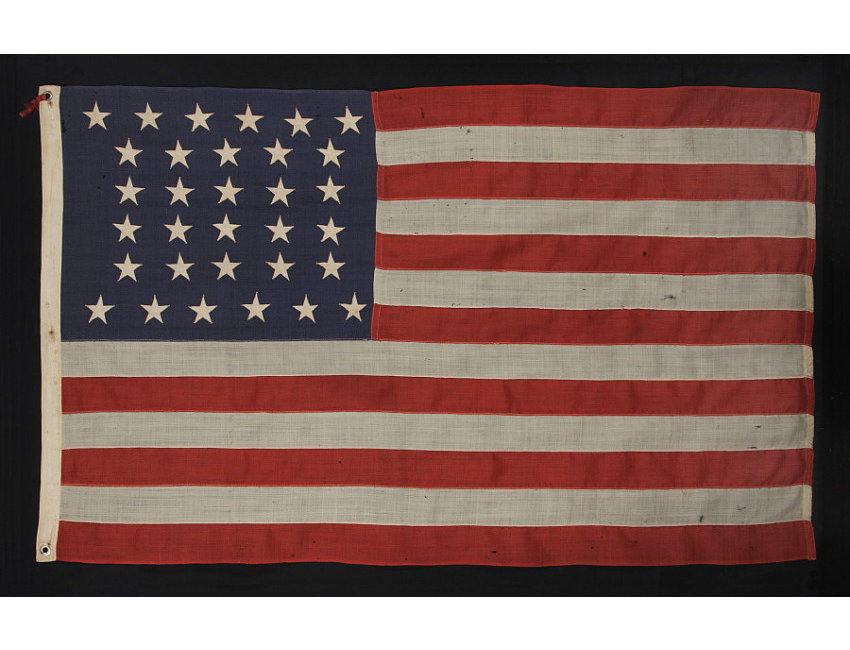|
32 STARS, COMMEMORATING MINNESOTA STATEHOOD, CA 1892 � 1926, A VERY RARE FLAG, IN A SMALL SIZE, WITH AN HOURGLASS CONFIGURATION:
|
|

|
Description: |
|
| 32 star American flags are rare. This is largely because they were only official for one year (1858-59), but it is also because their period of use was prior to the Civil War, in an era when use of the Stars & Stripes in the private sector was slim-to-non-existent.
Minnesota, the 32nd state, joined the Union on May 11th, 1858. The 32 star flag became official on July 4th of that year and remained so until July 3rd of 1859. But since Oregon joined the Union on February 14th (Valentines Day), 1859, production of 32 star flags probably ceased well before July.
Of the very few 32 star flags that do exist that were made in this short time frame, most are very large in size and ordinary in their appearance. There are fewer than fifteen in total that I have encountered in my experience; maybe fewer than ten. Large ship�s ensigns are the most common occurrence, but a couple of smaller flags are known, as well, including at least three sewn examples and two press-dyed flags that are printed on blended wool and cotton.
The stars on this flag are configured in rows of 6-5-5-5-5-6, with the top and bottom rows offset so that they resemble a broad hourglass. This is an attractive pattern that stands out from more common lineal formations. the particular way that the rows are staggered resembles yet another odd type of lineal configuration that I call �Global Rows�, because of the way in which the stars resemble a two-dimensional representation of a world map. This is seen on a notable variety of 34 star parade flag (1861-63), but is rarely seen in sewn examples of any period.
Some pre-Civil War star counts were reproduced after the Civil War for such things as World�s Fair events and anniversaries of statehood. For all practical purposes, however, 32 star flags were not. There is only one style known and within that style only 2 or 3 examples exist. This particular flag is one of them. It was likely produced sometime between 1892and 1926 for one of several purposes. Given its construction, the earliest viable theory is that it was made between 1892-93 for the Minnesota Pavillon at the 1893 Chicago World�s Fair (The World Columbian Exposition). The zigzag stitch used to appliqu� the stars was patented for use on flags in 1892. In itself this means relatively little in terms of dating the flag, as the zigzag stitch soon became the most popular method of applying stars to flags and it remained so until just after WWII. But the particular shade of indigo blue colored wool bunting and the hourglass star configuration are both suggestive of such a date. Both are seen frequently on 44 star examples made between 1890 and 1896. With larger rows at the top and bottom, the star configuration does look like the hourglass patterns that were popular among flags in the 44 star count.
Some alternative theories are that the flag might have been made for the 1904 World�s Fair in St. Louis (The Louisiana Purchase Exposition), or to celebrate the 50th anniversary of the addition of Minnesota in 1908, or for the Minnesota Pavillion at the U.S. Sesquicentennial Expo in Philadelphia in 1926 (our nation�s 150th anniversary of independence). Whatever the case may be, this particular variety remains undocumented in any text, but a remarkable postcard exists, dating sometime between the 1900 and the 1920's, which features an image of one of these exact flags at some kind of tented camp, perhaps during a Civil war or Spanish American War veteran's reunion. A copy of the image accompanies this flag.
Construction: The canton and stripes of the flag are constructed of wool bunting that has been pieced by machine. The stars, which all point upward, are double appliqu�d, made of cotton, and machine-sewn with a zigzag stitch. There is a twill cotton binding along the hoist with two white metal grommets. "3 x 5" is lightly penciled near the top of the hoist, on the obverse, to indicate size. The flag was found with a small length of red ribbon tied to the top grommet. This adds a nice visual feature and so was left intact.
Mounting: The flag has been stitched to 100% silk organza on every seam and throughout the star field. The flag was then hand-sewn to background of 100% cotton, black in color, which has been washed to remove excess dye. An acid-free agent was added to the wash to further set the dye and the fabric was heat-treated for the same purpose. The flag was then placed in a black-painted and hand-gilded, contemporary Italian molding. The front is U.V. protective plexiglas. |
| Inventory Number: |
|
|
|
Dealer |
Jeff R. Bridgman American Antiques, llc |
| Contact |
Jeff Bridgman |
Phone: (717) 502-1281 |
|
| Period: |
19th Century (1801-1900) |
|
| Date: |
1862-1926 |
|
| Origin: |
|
|
| Condition: |
There is very minor mothing, accompanied by minor foxing, but there are no significant condition issues. |
|
| Measurements: |
Frame: Approx. 46.5" x 71.5' Flag: 35.5" x 60.25" |
|
| Inventory |
Other Inventory by this Dealer |
|
| Web-site: |
http://www.jeffbridgman.com |
|
| Price: |
SOLD |
|
| E-mail: |
Inquire
|
|
Click thumbnail
to view larger
|
Views: 2594 |
|
|
|
